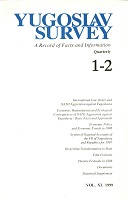Economic Policy and Economic Trends in 1998 (in Yugoslavia)
Economic Policy and Economic Trends in 1998 (in Yugoslavia)
Author(s): Miroslav FilipovićSubject(s): National Economy, Marxist economics
Published by: Jugoslovenski Pregled
Summary/Abstract: In the last few decades, Yugoslavia was developing a market-oriented centrally planned economy. Economic agents were often independently making decisions. Steps were taken at the beginning of this decade towards speeding up the conduct of market-oriented reforms of the system, including privatisation, which Yugoslavia had begun before any other country in transition. However, by the action of non-economic factors - the disintegration of the single market of the former Yugoslavia and the international community’s all-inclusive sanctions against Yugoslavia in the first place - the output and gross domestic product got more than halved and the formation and distribution of social product were disrupted substantially. The conduct of structural reforms was almost arrested. At the end of the hyperinflation year 1993, the social product was 56% less than that registered in 1989, and the per capita social product decreased from about US$ 3,000 to US$ 1,100, which corresponds to that registered in 1969. The unemployment rate reached 25%, while several hundred thousand workers were made redundant. The long-lived hyperinflation that reached its peak in January 1994 produced a destructive effect on the national monetary system.
Journal: Yugoslav Survey. A Record of Facts and Information
- Issue Year: XL/1999
- Issue No: 01+02
- Page Range: 27-60
- Page Count: 34
- Language: English

